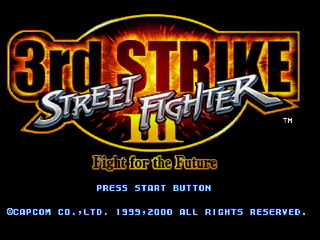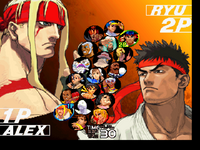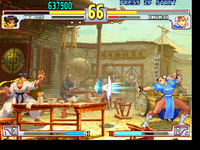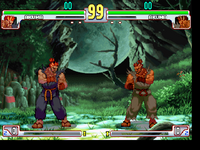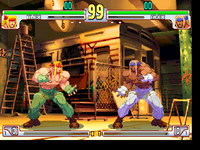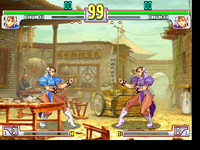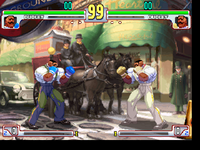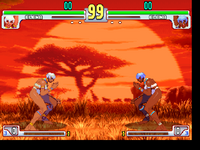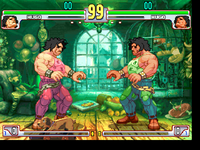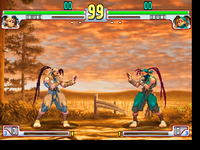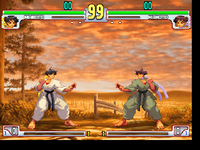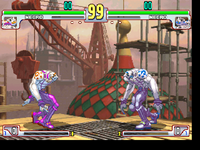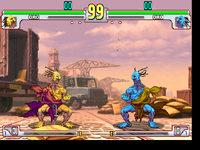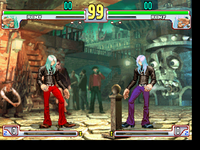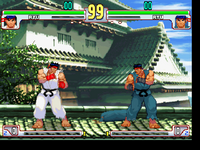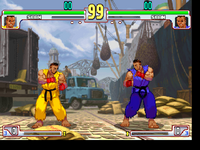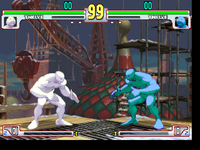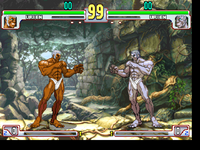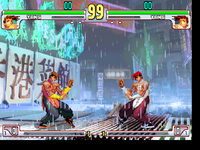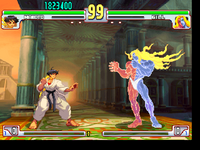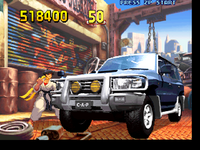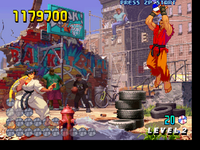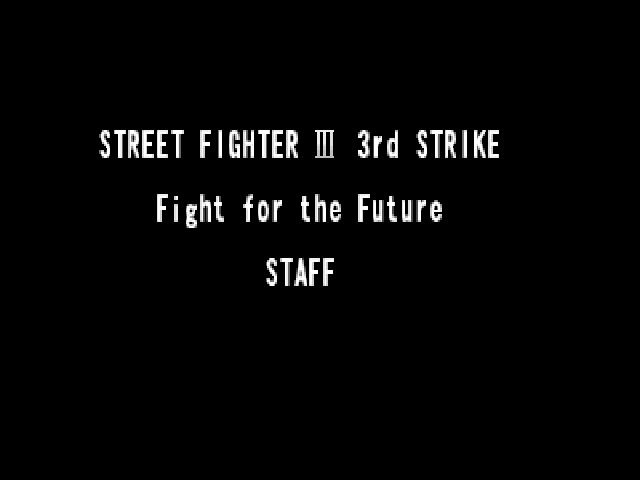Street Fighter III: 3rd Strike
From Sega Retro
| Street Fighter III: 3rd Strike | |||||||||||||||||||||||||||||||||||||||||||||
|---|---|---|---|---|---|---|---|---|---|---|---|---|---|---|---|---|---|---|---|---|---|---|---|---|---|---|---|---|---|---|---|---|---|---|---|---|---|---|---|---|---|---|---|---|---|
| System(s): Sega Dreamcast | |||||||||||||||||||||||||||||||||||||||||||||
| Publisher: Capcom (Japan, US), Virgin Interactive (Europe) | |||||||||||||||||||||||||||||||||||||||||||||
| Developer: Capcom | |||||||||||||||||||||||||||||||||||||||||||||
| Original system(s): Capcom CPS-3 | |||||||||||||||||||||||||||||||||||||||||||||
| Peripherals supported: Dreamcast Arcade Stick, Jump Pack, Dreamcast Keyboard, Dreamcast Modem, Visual Memory Unit, Dreamcast VGA Box | |||||||||||||||||||||||||||||||||||||||||||||
| Genre: Fighting/Taisen Kakutou (対戦格闘)[1][2], Action[3] | |||||||||||||||||||||||||||||||||||||||||||||
| Number of players: 1-2 | |||||||||||||||||||||||||||||||||||||||||||||
| |||||||||||||||||||||||||||||||||||||||||||||
|
Street Fighter III: 3rd Strike (ストリートファイターIII サードストライク), alternatively spelled Street Fighter III: Third Strike, is a one-on-one fighting game released for the arcades by Capcom in 1999. It was the third installment of the Street Fighter III sub-series and ran on the same CPS-3 arcade board as the first two entries. In 2000, Capcom released a standalone port of 3rd Strike for the Sega Dreamcast (following Street Fighter III: Double Impact, a compilation of the first two games).
Contents
Story
Years after the second World Warrior Tournament and the fall of Shaladoo, a third World Warrior Tournament is being held by a mysterious "secret society" called the Illuminati.
Gameplay
3rd Strike was the third and final release in the Street Fighter III series. Four new characters were added (Makoto, Q, Remy, and Twelve), Akuma was made a regular character, and Chun-Li was brought back from Street Fighter II. All returning characters received new moves, stages, and endings. The behaviors of existing moves (such reach, strength, and speed) were modified to improve the balance of the game. Throws and universal overheads are now performed by pressing a punch and kick of the same strength simultaneously, like Personal Actions. The series-unique parry maneuver can now also be performed while guarding, which results in a red flashing effect. This allows characters to parry an attack that hits multiple times even after blocking one or more hits. All music and sound effects were changed (including character voice lines and the announcer). The game also introduces a grading system in which the victorious player of a match is graded afterwards on offense, defense, techniques, and extra points.
Characters move with ![]() and
and ![]() and crouch with
and crouch with ![]() . They dash with
. They dash with ![]()
![]() or
or ![]()
![]() . They jump with
. They jump with ![]() and flip back and forth with
and flip back and forth with ![]() and
and ![]() . Characters can perform a high jump with
. Characters can perform a high jump with ![]()
![]() (which varies in height depending on the character). Each character has a set of normal attacks with differing properties such as speed or range. Punches are performed with
(which varies in height depending on the character). Each character has a set of normal attacks with differing properties such as speed or range. Punches are performed with ![]() (jab),
(jab), ![]() (medium), and
(medium), and ![]() (fierce), while kicks are performed with
(fierce), while kicks are performed with ![]() (short),
(short), ![]() (medium), and
(medium), and ![]() (roundhouse). Light attacks start up and recover faster and have a higher likelihood of connecting to an opponent. Hard attacks deal more damage but have lower attack priority and leave the character vulnerable for longer while the move starts up and recovers. Characters can additionally perform unique special moves using particular button combinations. Characters can perform a Personal Action by pressing the hard punch and kick buttons simultaneously (
(roundhouse). Light attacks start up and recover faster and have a higher likelihood of connecting to an opponent. Hard attacks deal more damage but have lower attack priority and leave the character vulnerable for longer while the move starts up and recovers. Characters can additionally perform unique special moves using particular button combinations. Characters can perform a Personal Action by pressing the hard punch and kick buttons simultaneously (![]() +
+![]() ). Personal Actions are similar to taunts but with unique effects for each character.
). Personal Actions are similar to taunts but with unique effects for each character.
Throws and grabs are done by pressing the light punch and kick buttons simultaneously (![]() +
+![]() ) when next to an opponent. This can optionally be paired with
) when next to an opponent. This can optionally be paired with ![]() or
or ![]() to throw in a particular direction. The character can "whiff" a grab by attempting it outside of range, leaving the character vulnerable to counterattack. Different characters have different throws available to them, and some characters can throw in midair. Throws cannot be blocked, but characters can recover for reduced damage by performing the same inputs as a throw immediately after being thrown. Characters can recover more quickly after being knocked down (from a throw or other attack) by pressing
to throw in a particular direction. The character can "whiff" a grab by attempting it outside of range, leaving the character vulnerable to counterattack. Different characters have different throws available to them, and some characters can throw in midair. Throws cannot be blocked, but characters can recover for reduced damage by performing the same inputs as a throw immediately after being thrown. Characters can recover more quickly after being knocked down (from a throw or other attack) by pressing ![]() upon landing on the ground.
upon landing on the ground.
Guarding is done by holding the D-Pad away from the opponent, which negates incoming damage. Special moves and Super Arts still do a small amount of tick damage when guarded. Characters can guard while standing or crouching, but not while jumping (unlike the Street Fighter Alpha games). Some attacks can only be guarded while crouching (such as sweeps) or while standing (such as jumping attacks and overhead strikes). Every character has a leap attack, performed by pressing the medium punch and kick buttons simultaneously (![]() +
+![]() ), which can hit characters who are guarding while crouched. Characters have visible stun meters under their vitality meters that fill as they take repeated attacks (and empty as they avoid attacks). If the meter fills, the character becomes stunned and vulnerable to attack for a moment. Players can recover from stuns and escape grabs more quickly by rapidly pressing back and forth on the D-Pad along with the attack buttons.
), which can hit characters who are guarding while crouched. Characters have visible stun meters under their vitality meters that fill as they take repeated attacks (and empty as they avoid attacks). If the meter fills, the character becomes stunned and vulnerable to attack for a moment. Players can recover from stuns and escape grabs more quickly by rapidly pressing back and forth on the D-Pad along with the attack buttons.
Characters can parry incoming attacks by pressing the D-Pad toward the opponent to parry a standing or a jumping attack or pressing ![]() to parry a crouching attack. Parries can be done in midair by pressing the D-Pad toward the opponent (regardless of the type of attack that is being parried). If executed at the exact moment that the attack is about to hit the character, the character flashes blue and averts the incoming attack; however, if the timing is wrong, the character is instead hit by the attack. Since performing a parry requires foregoing the option to guard because of the mutually exclusive controls, it is considered a high risk maneuver. However, the parrying character recovers much more quickly than attacking character, creating an opening for a counterattack. Parrying can be used against normal and special moves as well as some Super Arts, but not against throws or grabs. Parries can be done while guarding an attack consisting of multiple hits, in which case the character flashes red.
to parry a crouching attack. Parries can be done in midair by pressing the D-Pad toward the opponent (regardless of the type of attack that is being parried). If executed at the exact moment that the attack is about to hit the character, the character flashes blue and averts the incoming attack; however, if the timing is wrong, the character is instead hit by the attack. Since performing a parry requires foregoing the option to guard because of the mutually exclusive controls, it is considered a high risk maneuver. However, the parrying character recovers much more quickly than attacking character, creating an opening for a counterattack. Parrying can be used against normal and special moves as well as some Super Arts, but not against throws or grabs. Parries can be done while guarding an attack consisting of multiple hits, in which case the character flashes red.
As in previous games, characters have a Super meter that fills as they perform normal moves (except for light attacks), special moves (including Personal Actions), and parries. After selecting a character, the player can choose from one of three "Super Arts," which are super moves that can be performed once the Super meter is full. Only one Super Art can be chosen at a time, and the choice is permanent until the game ends. The length of the Super meter as well as the number of levels varies depending on the Super Art chosen, but every Super Art only costs one level of meter to perform (and there is only one level of strength for each Super Art, regardless of the strength of the button used to execute it). Generally, more powerful Super Arts require filling a longer meter while less powerful Super Arts have a shorter meter and allow the player to store multiple levels so that the move can be performed more. Normal and special moves can be canceled into Super Arts for combination attacks. Super meter power is carried over between rounds but not between matches.
Characters can also perform slightly more powerful versions of their special moves called EX Specials, which are similar to the ES moves introduced in Darkstalkers. These moves are performed by inputting the command for the special move and pressing two attack buttons of the same type (such as two punch buttons) instead of one. Using an EX Special costs a portion of the Super meter, depending on the move performed.
If a match goes three rounds without a victor (because of a draw or a double knockout), rather than continuing to a fourth round, three "Judgment Girls," female judges with different designs, walk out and decide the winner (based on unknown criteria).
Modes
The game contains the following modes:
- Arcade: A single-player mode where the player ten opponents, which includes a character-specific rival as the penultimate opponent and Gill as the final boss for each of the characters except for Gill himself (whose final boss is Alex). With the exception of these predetermined fights, the player is given a choice of two opponents to face before each match. A second player can challenge the first by pressing START , with the victor of the match continuing the game. There are eight difficulty levels for computer-controlled opponents. The game ends if the player loses a match but can be continued an unlimited number of times. The "Parry the Ball!" bonus stage from 2nd Impact returns as well as a new version of the "Crush the Car!" bonus stage from Final Fight and Street Fighter II.
- Versus: A two-player mode where each player chooses a character, their Super Arts, and a handicap and can pick any stage.
- Training: A practice mode where the player chooses a character and a Super Art for both fighters. There is a normal training mode where the player can practice moves against a dummy opponent and can set the opponent to stand, crouch, jump, or fight and also toggle guarding and enable infinite Super meter. The player also record practice sessions and play them back. There is also a parrying training mode where the player records attacks for the opponent, then practices parrying them as the other fighter.
Characters
Note: Move lists assume that the character is facing right. When facing left, ![]() and
and ![]() should be reversed.
should be reversed.
| P | Any punch button |
| LP | Light punch |
| MP | Medium punch |
| HP | Hard punch |
| K | Any kick button |
| LK | Light kick |
| MK | Medium kick |
| HK | Hard kick |
Playable
The entire cast from 2nd Impact returns. Akuma is no longer a hidden character.
Chun-Li returns from the Street Fighter II and Street Fighter Alpha series. Makoto, Q, Remy, and Twelve are new characters.
Bosses
Gill can be unlocked to play.
Rival battle: Urien
Final battle: Alex
|
Gill | |||||||||||||||||||||||||||||||||||||||||||||||
Gill is the leader of the Secret Society, also known as the Illuminati, a mysterious, cult-like organization that has manipulated world events for ages. He is the final opponent in the third World Warrior tournament. He resembles a Greek god, and his body is bifurcated into a blue half and a red half. The blue half has mastery over cryokinetic abilities, while the red half has mastery over pyrokinetic abilities, giving his attacks different properties depending on which direction he is facing.
|
Stages
Each character has his or her own stage where matches are hosted (with the exception of Q, who fights in the stage of the previous opponent). Some characters share the same stage but have their own unique color variations. The stage can be manually chosen in the two-player mode.
Bonus stages
A bonus stage appears in the single-player game after every three matches won.
Versions
The Dreamcast port adds a "System Direction" mode, a special options menu that allows users to customize numerous aspects of how the game works. The feature would be carried over to the later PlayStation 2 and Xbox versions of the game, as well as 3rd Strike Online Edition on the PlayStation 3 and Xbox 360. Aside from that, this port has a remixed soundtrack and the final boss Gill was made playable (same as Double Impact).
The PAL version supports 50Hz and 60Hz modes.
History
Legacy
For a while, this was the only home version of 3rd Strike available to consumers, although it was later ported to the PlayStation 2 and the Xbox a few years later.
Production credits
- Character Design: Who, Ikusan Z, D=Kurita, Chimorin Shogun, Sibaki♥, Chunzenji & Rute, Tsuyoshi, Jun-Ikawa, Toshihiro Suzuki, Noya‑T, Seiji Yano, Ryosuke "Hell" Naoi, Tomo, Hirano=Daichi, Izumi.N, Akiman
- Scroll Design: Imahori 75%, Sugiyama 50%, ♥Youko Fukumoto♥, Yuki Kyoutani, ☆Sawatch, Atushi, Ryo Uno, Yusuke Saiwai※, Kenichi Yamahashi
- Original Art Work: Daigoro, Harumaru
- Title Logo Design: Y.Uchida
- Instruction Design: Sakomizu
- Programming: Kazuhito Nakai, Nobuya "LT1" Yoshizumi, Yuko Kawamura (Tate), Hiroshi Nakagawa (Raoh), Y&M.Inada (Ine), Masahito Oh!Ya!, Akihiro ☆ Yokoyama
- Sound Effect Design: Satoshi Ise, Y.Sandou
- Music Compose: H. Okugawa
- Sound Editor: Kazuya Takimoto
- Sound Management Director: Yoshinori Ono
- Third Strike (Opening Theme Song)
- Let's Get It On (Event Theme Song)
- Moving On (Ending Song)
- Song Written by: Infinite/hideki
- Arranged by: hideki
- Vocals: Infinite (Courtesy of Lock Down Entertainment Inc.)
- Recording Engineer: Yutaka Shimoyama (Victor St.)
- Mix Engineer: Paul Shubat
- Assistant Engineer: Vladimir Nikolic
- Artist Management: Cain (Lock Down Entertainment Inc.)
- Voice Actor: Touru Ohkawa, Yuji Kishi, Mitsuo Iwata, Kentarou Itou, Masakazu Suzuki, Yuri Amano, Mie Midori, Takashi Matsuyama, Tomomichi Nishimura, Makoto Tsumura, Eiji Sekiguchi, Atsuko Tanaka, Lawrence Bayne, Patrick Gallagan, Francis Diakewsky, Len Carlson
- Planning: Neo_G H.Ishizawa, Haruo Murata, Numach (T.O), Yasunori Ichinose, Sada 36
- Special Thanks: Youichi Egawa, T.Shiraiwa, Abu, Tomoaki Tsuji, Tobuto (MAM2) Dezaki, Mitsuaki (TIM2) Araki, Takechan, Oni-Suzuki, Kaeru, Bug (H.Sugimoto), K.Shinano, Gon, Syachi (S.Ohoka), Yng.J.Matsubara, Miura Cuberick, Tetsuya Haze, Yoshihiro Tomita, HMX‑12 Hamada, Masayasu Mukai, Punch Kubozono, Tetsuya Iijima, Lisa E. Jones, Masayuki Fukumoto, Lance Luu, Nate Williams
- Message Translator: Erik Suzuki, Dan Okada, Chris Tang
- Producer: Noritaka Funamizu, Kouji Nakajima
- General Producer: Yoshiki Okamoto
- Character Design: Jun Ikawa, Yuji Imamura, Pu✰Chimorin, Toshihiro Suzuki, Tomo, Daichi=Hirano, Naonee, D-Kurita
- Scroll Design: Sawatch‑again, Yuki♥Kyoutani, Yusuke-Saiwai
- Original Art Work: Ikeno☆Mie
- Instruction Design: M.ru, Miduho☆, Y.Uchida
- Programming: Kazuhito Nakai, Nobuya "Gentle" Yoshizumi, Hiroshi "Raoh" Nakagawa, MaSaHiTo Oh!Ya! (MSHTOY), Kohei Akiyama, Tomohiro Ueno, Batayon, Meijin
- Sound: Hiro "X68k" Kondo, Yoshiki Sandou
- Music: 8bit@okugawa
- Recorded: Kazuya Takimoto
- Planning: Neo_G H.Ishizawa, Haruo Murata, Tomonori Ohnuma
- Special Thanks: Hideki Ohnuki, Keiko Harakawa, Michiyo Aoki, Hiromitsu Furubeppu, Toshiaki Matsuda, Takako Akutagawa, Ryosuke Hagiwara, Abu, Yoshinori Ono, Shin., Ichiro Yunde, Net Man, Mineyuki Noda, Kentaro✰Kaneko, Hideaki Itsuno, Ika★chan, momo‑mo, Takuya Shiraiwa, Erik (ESX) Suzuki
- (Bug Checkers): Katusuke F Miura, Minoru A Horike, Masayasu Y Mukai, Yoshihiro 775 Tomita, HMX-12 Hamada, Tetsuya Rappayar Takagi, Shutaro Jerry Kobayashi, Taizo "Tom" Iwata, SS・Tsu・Ten・Kaku, Yng J Matsubara, Kuroe K・K Yasushi QChan, MatMan-Boo!, nosetake, Chikahiro Kawanishi, Haya (Shi) 2Nji, Kouichi Takemoto, "Urien" hirata, Akihide Maeda, Natsuko Ozaki, Minako Murakami, Masatoshi Inuino, Kouki Mori, noseyumi, Terumas@ Iwaki, Syoji Araki, Ume-Zono
- Director: Hidetoshi Ishizawa
- Producer: Yoshihiro Sudo
- General Producer: Noritaka Funamizu
- Executive Producer: Yoshiki Okamoto
- And Capcom All Staff
- Presented by: Capcom
- Network: Shin., Ichiro Yunde, Net Man, Mineyuki Noda, Kentaro✰Kaneko, Hideaki Itsuno
- Homepage Design: Ika★chan, momo‑mo
Magazine articles
- Main article: Street Fighter III: 3rd Strike/Magazine articles.
Promotional material
Physical scans
| Sega Retro Average | ||||||||||||||||||||||||||||||||||||||||||||||||||||||||||||||||||||||||||||||||||||||||||||||||||||||||||||||||||||||||||||||||||||||||||||||||
|---|---|---|---|---|---|---|---|---|---|---|---|---|---|---|---|---|---|---|---|---|---|---|---|---|---|---|---|---|---|---|---|---|---|---|---|---|---|---|---|---|---|---|---|---|---|---|---|---|---|---|---|---|---|---|---|---|---|---|---|---|---|---|---|---|---|---|---|---|---|---|---|---|---|---|---|---|---|---|---|---|---|---|---|---|---|---|---|---|---|---|---|---|---|---|---|---|---|---|---|---|---|---|---|---|---|---|---|---|---|---|---|---|---|---|---|---|---|---|---|---|---|---|---|---|---|---|---|---|---|---|---|---|---|---|---|---|---|---|---|---|---|---|---|---|
|
| 78 | |
|---|---|
| Based on 28 reviews | |
Technical information
- Main article: Street Fighter III: 3rd Strike/Technical information.
ROM dump status
| System | Hash | Size | Build Date | Source | Comments | |||||||||
|---|---|---|---|---|---|---|---|---|---|---|---|---|---|---|
| ? |
|
GD-ROM (JP) | ||||||||||||
| ? |
|
GD-ROM (US) | ||||||||||||
| ? |
|
GD-ROM (EU) | ||||||||||||
| ? |
|
2000-06-07 | GD-R | Page | ||||||||||
| ? |
|
2000-08-10 | GD-R | Page |
External links
References
- ↑ File:StreetFighterIII3rdStrike DC JP Box Back.jpg
- ↑ 2.0 2.1 2.2 http://sega.jp/dc/000608/ (Wayback Machine: 2014-08-03 22:34)
- ↑ https://sega.jp/history/hard/dreamcast/software_l.html#tab01 (Wayback Machine: 2020-02-01 22:57)
- ↑ 4.0 4.1 Press release: 2000-10-04: Street Fighter III: Third Strike Now Available
- ↑ http://www.capcom.com/xpml/game.xpml?gameid=550026 (Wayback Machine: 2000-12-19 17:16)
- ↑ http://www.chipsworld.co.uk/detProd.asp?ProductCode=3168 (Wayback Machine: 2003-11-27 09:46)
- ↑ http://www.amazon.co.uk/exec/obidos/tg/browse/-/300724/ (Wayback Machine: 2001-06-23 23:00)
- ↑ 8.0 8.1 DC-UK, "December 2000" (UK; 2000-10-23), page 72
- ↑ http://www.micromania.fr/zooms/?ref=17519 (Wayback Machine: 2002-11-04 12:38)
- ↑ http://www.centromail.es/top/ficha.asp?codmail=16155&codprov= (Wayback Machine: 2001-09-17 09:30)
- ↑ http://www.futuregamez.net:80/outnow/dc.html (Wayback Machine: 2001-07-31 23:17)
- ↑ File:Street Fighter III 3rd Strike DC credits.pdf
- ↑ Ação Games, "Setembro 2000" (BR; 2000-xx-xx), page 67
- ↑ Consoles +, "Août 2000" (FR; 2000-07-xx), page 102
- ↑ Digitiser (UK) (2001-01-22)
- ↑ Dreamcast Magazine, "2000-22 extra (2000-07-07ex)" (JP; 2000-06-23), page 37
- ↑ Dreamcast Magazine, "No. 14" (UK; 2000-10-05), page 60
- ↑ Dorimaga, "2002-18 (2002-10-11)" (JP; 2002-09-27), page 34
- ↑ Dreamzone, "Juillet/Août 2000" (FR; 2000-07-15), page 104
- ↑ Edge, "September 2000" (UK; 2000-08-14), page 105
- ↑ Electronic Gaming Monthly, "December 2000" (US; 2000-10-30), page 208
- ↑ Entsiklopediya igr dlya Dreamcast, "Izdaniye chetvertoye, dopolnennoye" (RU; 2002-xx-xx), page 240
- ↑ Famitsu, "2000-07-07" (JP; 2000-06-23), page 35
- ↑ Fun Generation, "09/2000" (DE; 2000-08-23), page 99
- ↑ GameFan, "Volume 8, Issue 9: September 2000" (US; 2000-xx-xx), page 22
- ↑ GameFan, "Volume 8, Issue 12: December 2000" (US; 2000-1x-xx), page 26
- ↑ GamePro, "December 2000" (US; 2000-1x-xx), page 153
- ↑ Game Informer, "November 2000" (US; 2000-1x-xx), page 125
- ↑ Gamers' Republic, "November 2000" (US; 2000-xx-xx), page 71
- ↑ MAN!AC, "09/2000" (DE; 2000-08-02), page 43
- ↑ MAN!AC, "01/2000" (DE; 2000-12-06), page 87
- ↑ Neo Plus, "Marzec 2001" (PL; 2001-xx-xx), page 43
- ↑ Next Generation, "December 2000" (US; 2000-11-21), page 115
- ↑ Official Dreamcast Magazine, "December 2000" (UK; 2000-11-02), page 98
- ↑ Official Dreamcast Magazine, "November 2000" (US; 2000-10-03), page 117
- ↑ Playmag, "Septembre 2000" (FR; 2000-xx-xx), page 39
- ↑ PSX Extreme, "03/2001" (PL; 2001-0x-xx), page 41
- ↑ Video Games, "09/2000" (DE; 2000-08-02), page 107
- ↑ Video Games, "12/2000" (DE; 2000-11-02), page 73
| Street Fighter III: 3rd Strike | |
|---|---|
|
Main page | Comparisons | Hidden content | Development | Magazine articles | Video coverage | Reception | Compliance | Technical information | |
| Street Fighter games for Sega systems | |
|---|---|
| Street Fighter II': Champion Edition (unreleased) | Street Fighter II': Special Champion Edition (1993) | Super Street Fighter II: The New Challengers (1994) | |
| Street Fighter: The Movie (1995) | Street Fighter Alpha: Warriors' Dreams (1996) | Street Fighter II Movie (1996) | Street Fighter Alpha 2 (Dash) (1996) | Super Puzzle Fighter II Turbo (1996) | Street Fighter Collection (1997) | X-Men vs. Street Fighter (1997) | Pocket Fighter (1998) | Marvel Super Heroes vs. Street Fighter (1998) | Capcom Generation: Dai 5 Shuu Kakutouka-tachi (1998) | Street Fighter Zero 3 (1999) | |
| Street Fighter II' (1997) | |
| Street Fighter Alpha 3 (1999) | Street Fighter III: Double Impact (1999) | Street Fighter III: 3rd Strike (2000) | Super Street Fighter II X for Matching Service (2000) | Street Fighter Zero 3 for Matching Service (2001) | Super Puzzle Fighter II X for Matching Service (2001) | |
| Street Fighter Zero 3 Upper (2001) | |
| Sampler discs | |
| Street Fighter Zero 2 Taikenban (199x) | Street Fighter Collection Taikenban (1997) | |
| Street Fighter Zero 3 Tentou Taikenban (199x) | |
| Unlicensed Street Fighter games for Sega systems | |
| Jang Pung II (1993) | |
| X-Men vs. Street Fighter (Mega Drive) (1998) | |
- Dreamcast Arcade Stick-compatible games
- Dreamcast Keyboard-compatible games
- Jump Pack-compatible games
- Dreamcast Modem-compatible games
- Dreamcast VGA Box-compatible games
- Visual Memory Unit-compatible games
- 1-2 player games
- JP Dreamcast games
- All JP games
- US Dreamcast games
- All US games
- EU Dreamcast games
- All EU games
- DE Dreamcast games
- All DE games
- ES Dreamcast games
- All ES games
- FR Dreamcast games
- All FR games
- UK Dreamcast games
- All UK games
- AU Dreamcast games
- All AU games
- Dreamcast games
- 2000 Dreamcast games
- All 2000 games
- Dreamcast fighting games
- All fighting games
- Dreamcast games with ADX audio
- Dreamcast games using Flash
- Use romtable template
- All games
- Credits without reference
- Missing ROM hashes
- Games with known prototypes
- Old technical information
- Street Fighter III: 3rd Strike
- Street Fighter
